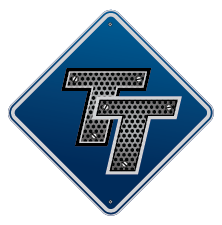Tankers... Do They Change The Substances They Haul?
Topic 18690 | Page 1
Good question.
Usually if you're hauling a certain substance you always haul that substance or something similiar to it. I haven't ever heard of companies hauling gasoline, then crude oil, then jet fuel one after another in the same compartment. This is due to strict regulations.
You have a few ways to clean out a hazmat trailer but the most common for me is drain dry which is basically having your valves open as well as internal and you drain all the left over liquid into a bucket and dump it into where you just delivered or if you're in a loading facility, their water/gas seperator drain/pump.
Fuels like jet fuel are extremely strict because they dont want planes flying out of the sky, so they are tightly regulated and each load is measured for a proper API.
Also, you cannot load ethanol if previous load was diesel, lube oil or transmix.
After a delivery you will always still have some product remaining. You just cant get every single gallon out. I'd estimate about 1 gallon still remains which can be a problem depending on what product you will load on top of it. If you just had diesel you can load gasoline in it without worry because diesel doesn't harm gas that much.
However, if you just delivered gas and you need to load diesel in that compartment then you need to drain dry. Even a small amount of gas destroys an entire diesel load and if tested at the station by the ARB your company will be held responsible.
HAZMAT:
Hazardous Materials
Explosive, flammable, poisonous or otherwise potentially dangerous cargo. Large amounts of especially hazardous cargo are required to be placarded under HAZMAT regulations
Chris, that is exactly the reason why food grade tankers have no baffles in them. That way someone can get inside that thing to wash it out. Food grade tankers are regularly washed so last week's orange juice doesn't get mixed in with this week's cooking oil.
Baffle:
A partition or separator within a liquid tank, used to inhibit the flow of fluids within the tank. During acceleration, turning, and braking, a large liquid-filled tank may produce unexpected forces on the vehicle due to the inertia of liquids.
Chris, that is exactly the reason why food grade tankers have no baffles in them. That way someone can get inside that thing to wash it out. Food grade tankers are regularly washed so last week's orange juice doesn't get mixed in with this week's cooking oil.
A part of me wonders if this is a waste of time though. I mean, come on, most of the beverages we drink contain so much garbage and genetically modified crap that I don't think putting a little bit of cooking oil in orange juice would even hurt it.
By the way Chris, look at the manifolds on the bottom of the tanker. Some things are loaded into the compartment from the dome on the roof of the tanker and then gravity dropped or pumped out and some are bottom loaded through the manifolds and gravity dropped or pumped out. The way the tank is set up and manifactured can say a ton about what its used for.
Baffle:
A partition or separator within a liquid tank, used to inhibit the flow of fluids within the tank. During acceleration, turning, and braking, a large liquid-filled tank may produce unexpected forces on the vehicle due to the inertia of liquids.A part of me wonders if this is a waste of time though.
A tanker that just hauled a load of honey doesn't just dry out and have the last product evaporate so quickly as a tanker full of unleaded gasoline. Food grade tankers get regular washouts, just like reefers have to be washed after hauling dead chickens.
You don't put a load of potatoes into a reefer full of chicken blood, and you don't load cooking oil into an unwashed tanker that just hauled a load of raw milk.
Reefer:
A refrigerated trailer.
A part of me wonders if this is a waste of time though
With food grade, not only do you have substances that don't mix well and the obvious bacterial issues, but you have a pump on the truck with very tight tolerances that will be a gummed-up mess if it isn't disassembled and cleaned properly.
When you take a food grade tanker to be cleaned they crawl right down inside there and make sure every inch of it is clean. I even had to have the inside of a food grade tank polished one time because there was an odor in there they couldn't get out. I can't even remember what they used for that, to be honest, but it took a few hours.
After you get a food grade tank washed they put a seal on the tank and on the pump so that the next shipper knows nothing was opened up and contaminated after the cleaning.
Shipper:
The customer who is shipping the freight. This is where the driver will pick up a load and then deliver it to the receiver or consignee.
Woah woah woah! I was kidding! Tanker endorsement test 101

Woah woah woah! I was kidding! Tanker endorsement test 101
Actually - NONE of that is on the tanker test - cept for the baffles part.
Got a close friend that drives food grade. He "changes substances" often. The dairy places require a way more stringent washout than the juice/etc. ones. Many food grade shippers, have scales onsite, and require you to come in with full fuel tanks so they can "gross out" your load. They weigh you coming in, then load you to max weight, and scale you going out. You probably want to hit a scale yourself, if they get you upwards of 78K, just in case. Tanker tandems don't slide - so there's no "adjusting tandems" to get your axles right.
Rick
Shipper:
The customer who is shipping the freight. This is where the driver will pick up a load and then deliver it to the receiver or consignee.
Baffle:
A partition or separator within a liquid tank, used to inhibit the flow of fluids within the tank. During acceleration, turning, and braking, a large liquid-filled tank may produce unexpected forces on the vehicle due to the inertia of liquids.Tandems:
Tandem Axles
A set of axles spaced close together, legally defined as more than 40 and less than 96 inches apart by the USDOT. Drivers tend to refer to the tandem axles on their trailer as just "tandems". You might hear a driver say, "I'm 400 pounds overweight on my tandems", referring to his trailer tandems, not his tractor tandems. Tractor tandems are generally just referred to as "drives" which is short for "drive axles".
Tandem:
Tandem Axles
A set of axles spaced close together, legally defined as more than 40 and less than 96 inches apart by the USDOT. Drivers tend to refer to the tandem axles on their trailer as just "tandems". You might hear a driver say, "I'm 400 pounds overweight on my tandems", referring to his trailer tandems, not his tractor tandems. Tractor tandems are generally just referred to as "drives" which is short for "drive axles".
New Reply:
New! Check out our help videos for a better understanding of our forum features

















Preview:








 TT On Facebook
TT On Facebook
Okay so every now and then i pass this trucking business that has nothing but tankers on its lot. Shiny tanks hauled by nice looking peterbilts! One was bright orange . This made me wonder if tankers in general ever switch the substance they haul and if so how in the world does a tanker get successfully cleaned inside out. Does one ever go from hauling oil to gas or oxygen to other chemicals. I imagine certain ones are made for gas or oxygen or oil.